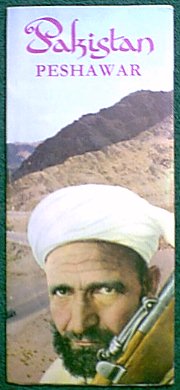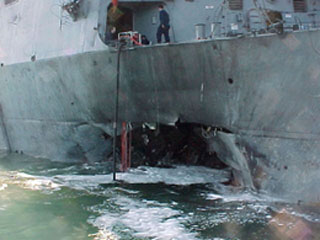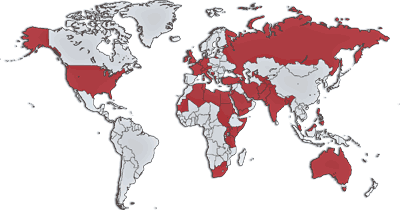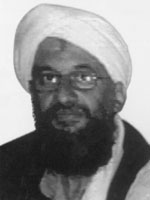|
al Qaeda Ah, scenic Peshawar!
Ah, scenic Peshawar!
Pakistan's government tourism department has the following to say about the city: "Peshawar derives its name from a Sanskrit word 'Pushpapura' meaning the city of flowers. Peshawar’s flowers were mentioned even in Moghal Emperor Babur’s memoirs." However, a 1967 travel brochure gives a more accurate picture of Peshawar's main attraction -- depicting a beautiful mountain range as the backdrop for a mujahideen fighter brandishing a rifle. In 1988, the "city of flowers" played host to the birth of al Qaeda -- the most feared and most dangerous terrorist organization in history. Many Americans were unfamiliar with al Qaeda until Sept. 11, 2001, when the terror conglomerate staged the September 11 attacks on America. Using the group's trademark style of tightly coordinated, high-profile violence, al Qaeda operatives hijacked four U.S. airliners and successfully crashed two of them into the World Trade Center towers, with a third hitting the Pentagon and a fourth crashing in rural Pennsylvania after the passengers attempted to regain control of the plane. Osama bin Laden is the primary founder of al Qaeda (which means "The Base" in Arabic), and he continues to be the organization's leader and driving force. After fighting the Soviets in Afghanistan, with the backing of the United States, bin Laden had developed a taste for jihad, which was originally the concept of a holy war designed to liberate occupied Muslim lands.
Like any enemy of the Soviets, bin Laden was a favored ally of the CIA, which for a time tried to foment a full-fledged jihad between Islamic extremists and the Soviets. bin Laden and many of the mujahideen had been trained and funded by the CIA over the court of the decade-long occupation. After the Soviet withdrawal, al Qaeda was quiescent for a couple of years, quietly building a financial and operation infrastructure while bin Laden returned to his native Saudi Arabia as a war hero. bin Laden raised money for the cause among his wealthy Saudi peers. When the Gulf War broke out in 1991, bin Laden offered to raise an army of mujahideen in defense of Saudi Arabia, but he was spurned in favor of U.S. assistance. He considered the U.S. presence in the Persian Gulf offensive and beginning around 1992, he led al Qaeda into a new role, with the stated purpose of driving U.S. forces out of the Gulf.
Some theories suggest that al Qaeda was behind the Oklahoma City bombing, but there is no conclusive evidence to support that -- yet.
Worldwide ReachFrom the Peshawar tourism brochure: "Peshawar is now, as always, very much a frontier town. The formalities of dress and manner give way here to a free and easy style, as men encounter men with a firm hand-clasp and a straight but friendly look. Hefty handsome men in baggy trousers and long, losse shirts, wear bullet studded bandoleers across their chests or pistols at their sides as a normal part of their dress."al Qaeda's operational headquarters in Afghanistan was disrupted by a U.S. invasion in early 2002. No intelligence exists as to what sort of headquarters operation might remain, but several of the group's top leaders have been captured in Pakistan in 2002 and 2003, and several more are suspected to be hiding in the region.
It might be easier to list countries where al Qaeda is known not to be operating. For instance, um... Well, the Principality of Sealand is probably a safe bet. And possibly the Vatican. According to Jane's, al Qaeda is informally allied with at least 24 other terrorist groups, including Palestinian Islamic Jihad, Egyptian Islamic Jihad, Abu Sayyaf, Jemaah Islamiah, Hezbollah, Hamas, Hesb' I Islami and the Islamic Group. bin Laden is the top leader of al Qaeda, and its most visible figurehead. While he provides inspiration and a cohesive ideological center for the organization, he is likely not involved in day-to-day operations. According to an intelligence source quoted by Simon Reeve in his book "The New Jackals," "Going after bin Laden to stop terror is like going after the Colonel to attack KFC." After being stripped of his Saudi citizenship, he set up operations in Sudan and subsequently in Afghanistan. His current whereabouts are unknown, but rumor places him in the mountainous border region between Pakistan and Afghanistan. He is the most wanted terrorist in the world, and the FBI offers a $25 million reward for information leading to his capture.
Until March 2003, al Qaeda's third-in-command was thought to be Khalid Shaikh Mohammed, a tactical mastermind connected to nearly every major al Qaeda attack in the last decade, including the 1993 World Trade Center bombing. Thought to be the mastermind behind the Sept. 11 attack, he was recently captured in Pakistan and is being held by the United States in an unknown location.
Current StatusFrom the Peshawar tourism brochure: "There is just that little touch of excitement and drama in the air that makes for a frontier land. An occasional salvo of gun fire-no, not a tribal raid or a skirmish in the streets but a lively part of wedding celebrations."The invasion of Afghanistan drove most of Qaeda's leadership out of the country, and many of them are now thought to be in Pakistan, whose intelligence services have been in cahoots with the terrorist network for several years. Now a U.S. "ally" in the war on terrorism, Pakistan has been working closely with the CIA and the FBI to capture Qaeda operatives working throughout the country, including at safehouses and in training camps around "the City of Flowers." The regional and international manhunts have likely damaged al Qaeda's ability to execute major attacks, substantial evidence suggests that the network still has hundreds or thousands of operatives at large across the globe, including sleeper agents and others in the United States. Other centers of activity include Southeast Asia. The Islamic terrorist organization Jemaah Islamiah is closely aligned with al Qaeda, and is engaged in an active war of terror with the goal of creating what Time Magazine called an "Islamic super-state," a single unified Islamic regime ruling "Indonesia, Malaysia, Singapore, the Sultanate of Brunei and parts of the southernmost areas of the Philippines, Thailand and even Cambodia." Jemaah Islamiah is one of the biggest wild cards in estimating al Qaeda's current capabilities. The group is led by an enigmatic fanatic known as Hambali. Reports are unclear as to whether Hambali is a lieutenant of Osama bin Laden, or a peer. The only thing that is certain is that the two are tied. A 2002 terrorist attack on nightclubs in Bali was executed by JI and is thought to have been planned by Khalid Shaikh Mohammed. bin Laden's brother-in-law Mohammed Jamal Khalifa is financially linked to Hambali, as well as to several terror groups operating in the Philippines. Wanted by the FBI and the CIA, Khalifa is living freely in Saudi Arabia with the sanction of the government there. Whatever the future holds, al Qaeda will almost certainly continue to pose a threat to Western influences and the stability of governments across the Mideast and Southeast Asia. Just one small gift to the world from the "City of Flowers." As the government-sanctioned tourism brochure notes, the colorful natives are still busily "keeping the border simmering with commotion and the flame of freedom proudly burning." Whose side are these guys on again?
Timeline
|
 During the Afghan jihad, bin Laden worked for Sheikh Abdullah Azzam, who ran a paramilitary group of mujahideen (holy warriors) called "The Office of Services." bin Laden quietly broke with Azzam to create al Qaeda in 1988, just before the Soviet withdrawal. The
During the Afghan jihad, bin Laden worked for Sheikh Abdullah Azzam, who ran a paramilitary group of mujahideen (holy warriors) called "The Office of Services." bin Laden quietly broke with Azzam to create al Qaeda in 1988, just before the Soviet withdrawal. The  al Qaeda launched a series of terrorist attacks against the United States, starting with a failed attempt to target U.S. troops in Yemen in 1992, Subsequent attacks include numerous embassy bombings, a boat attack on the U.S.S. Cole, bombings of airplanes and movie theaters out of the Philippines. al Qaeda has also been linked to recent attacks on the U.S. Consulate in Karachi, Pakistan, and on a nightclub in Bali.
al Qaeda launched a series of terrorist attacks against the United States, starting with a failed attempt to target U.S. troops in Yemen in 1992, Subsequent attacks include numerous embassy bombings, a boat attack on the U.S.S. Cole, bombings of airplanes and movie theaters out of the Philippines. al Qaeda has also been linked to recent attacks on the U.S. Consulate in Karachi, Pakistan, and on a nightclub in Bali.
 At heart, however, al Qaeda is a highly decentralized international organization. According to Jane's Intelligence Review, al Qaeda is a "conglomerate of quasi-independent Islamic terrorist cells in countries spread across at least 26 countries, including Algeria, Morocco, Turkey, Egypt, Syria, Uzbekistan, Tajikistan, Burma, Lebanon, Iraq, Saudi Arabia, Kuwait, Indonesia, Kenya, Tanzania, Azerbaijan, Dagestan, Uganda, Ethiopia, Syria, Tunisia, Bahrain, Yemen, Bosnia as well as the West Bank [and China]." Other countries where al Qaeda is known to have covert operational cells include Pakistan, the
At heart, however, al Qaeda is a highly decentralized international organization. According to Jane's Intelligence Review, al Qaeda is a "conglomerate of quasi-independent Islamic terrorist cells in countries spread across at least 26 countries, including Algeria, Morocco, Turkey, Egypt, Syria, Uzbekistan, Tajikistan, Burma, Lebanon, Iraq, Saudi Arabia, Kuwait, Indonesia, Kenya, Tanzania, Azerbaijan, Dagestan, Uganda, Ethiopia, Syria, Tunisia, Bahrain, Yemen, Bosnia as well as the West Bank [and China]." Other countries where al Qaeda is known to have covert operational cells include Pakistan, the  al Qaeda's second-in-command and functional chief of operations is
al Qaeda's second-in-command and functional chief of operations is